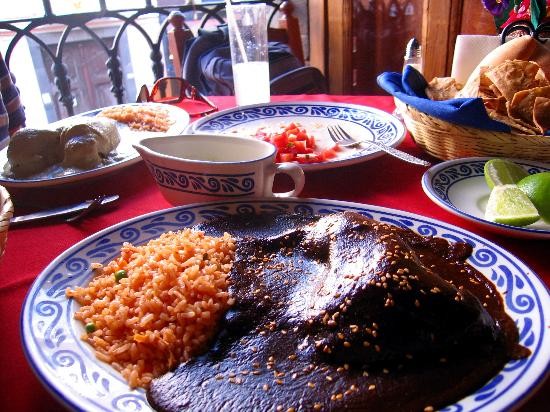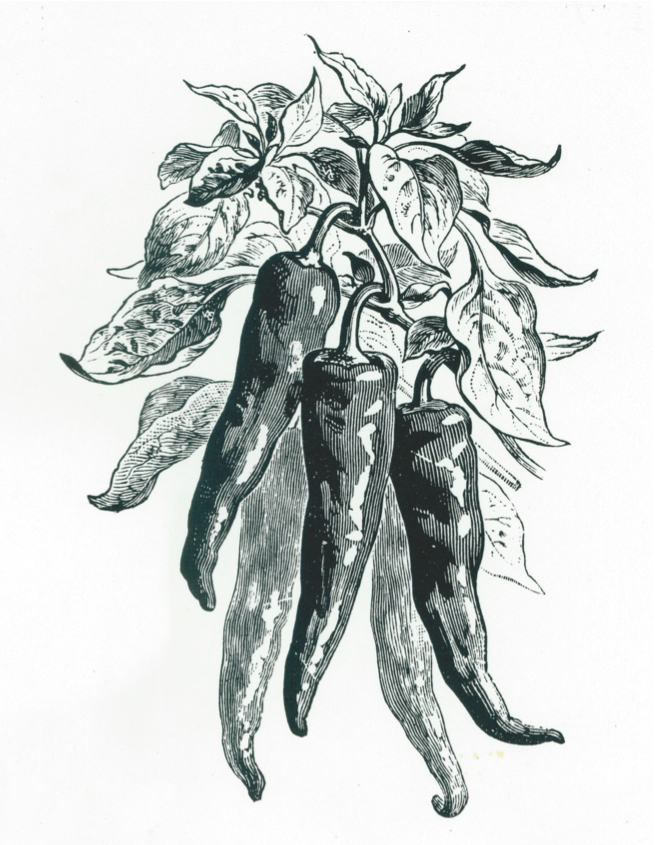 The color of a particular mole depends mostly upon the varieties of chiles utilized. A green mole consists mostly of poblano chiles while a red mole could contain three or four different varieties of dried red chiles, such as chiles de árbol, or cascabels. The brown and black moles owe their color to pasillas and anchos, both of which are sometimes called “chile negro” because of their dark hues when dried. The dark color of mole negro can also be the result of roasting the chiles until they are almost black, as is the custom in Oaxaca.
The color of a particular mole depends mostly upon the varieties of chiles utilized. A green mole consists mostly of poblano chiles while a red mole could contain three or four different varieties of dried red chiles, such as chiles de árbol, or cascabels. The brown and black moles owe their color to pasillas and anchos, both of which are sometimes called “chile negro” because of their dark hues when dried. The dark color of mole negro can also be the result of roasting the chiles until they are almost black, as is the custom in Oaxaca.
Other than chiles, there are literally dozens of other ingredients added to the various moles, including almonds, anise, bananas, chocolate, cinnamon, cilantro, cloves, coconut, garlic, onions, peanuts, peppercorns, piñons, pumpkin seeds, raisins, sesame seeds, toasted bread, tomatillos, tomatoes, tortillas, and walnuts. Undoubtedly, some moleros add coriander, cumin, epazote, oregano, thyme, and other spices to their moles.
But Puebla is not the only state in Mexico with a reputation for moles. Oaxaca, in the south, lays claim to seven unique moles–and dozens and dozens of variations. Susana Trilling, who owns the Seasons of My Heart cooking school located outside of Oaxaca city at Rancho Aurora, was our guide to the moles of Oaxaca. During a trip to her school, I was given lessons on preparing the famous mole negro Oaxaqueño, while Susana described her experiences with the seven famous moles. She later wrote about the moles in a Chile Pepper magazine article entitled: “My Search for the Seventh Mole.”
Susana wondered about the number seven, because there are seven regions in the state of Oaxaca, and, of course, seven days in the week. But then she read Tradiciones Gastronómicas Oaxaqueñas, in which the author, Ana Maria Guzmán de Vasquez Colmenares, noted: “There must be something magical in the number seven, for the number of Oaxacan moles coincides with the wonders of the world, the theological virtues, the wise men of Athens–and for their wisdom which elected the number seven to represent justice.”
“There may be seven moles,” say the locals, “but of the thousands and thousands of cooks, each has their own private version of all of the moles, so how many does that make?” One magazine writer suggested: “Oaxaca should be the land of 200 moles!”
For the record, the seven moles are: mole negro, mole coloradito, mole verde, mole amarillo, mole rojo, manchas manteles (“tablecloth stainer”), and mole chichilo. They are all descendants of clemole, believed to be the original mole of Oaxaca. It was quite simple, being composed of ancho and pasilla chiles, garlic, cloves, cinnamon, and coriander.
The Oaxacan moles are characterized by unusual chiles that are unique to the region. In a discussion with chile vendor Eliseo Ramirez, I learned that there are sixty chiles grown only in the state of Oaxaca and nowhere else in Mexico. Of those sixty, he carried about ten. Some of these unusal chiles in clude chiles de agua, which grow erect and are pointed at the end. The chiles chilhuacle, which are short and fat, come in two varieties, black and red. The red variety is called “the saffron of the poor” because a small amount of ground chilhuacle rojo gives are similar coloring to foods. Other unique chiles are the red-orange chiles onzas, the yellow costeño, and the pasilla Oaxaqueña (sometimes called pasilla Mexicana), a smoked pasilla that adds a chipotle-like flavor to moles.
In the market, I also learned an easy way to make moles. Instead of tediously grinding all the ingredients on a metate, the cooks would go to the Benito Juárez market, buy all their chiles, nuts, and seeds, and have them custom-ground in the special molinos, or mills in another section of the market. The result is a dark paste which is later converted into a mole sauce.
Susana Trilling describes the more tedious process: “The chiles are toasted black, soaked and ground, and blended with fried tomatoes, tomatillos, and roasted garlic and onions. Then come nuts and seeds–some toasted, some fried. Almonds, peanuts, pecans, chile seeds, and sesame seeds. There are almost always more sesame seeds than any other seed or nut. They have to be fried slowly and carefully, with lots of love and attention. Hence the affectionate Mexican dicho (saying): “You are the sesame seed of my mole.”
There are other special ingredients which characterize the different Oaxacan moles. Avocado leaves, difficult to find in the U.S. and Canado, are used in mole negro. Fresh green herbs such as epazote and parsley are the source of the green color of mole verde. Pineapple and banana are added to manchas manteles, while string beans, chayote and chiles costeños are ingredients in mole amarillo.
Many different meats are added to moles, from chicken to beef to fish, but by far the most common meat served is turkey. In fact, turkey is so important in mole negro, that Mexican writer Manuel Toussaint noted that the turkey in the mole was as important as the eagle in the Mexican flag, and another writer suggested that to refuse to eat mole negro was a crime of treason against the homeland!
See Part 1, here.
See Part 2, here.
Return to the Beginning, here.








